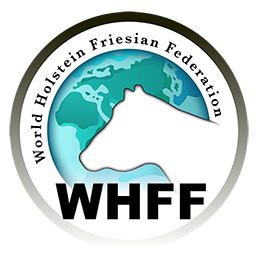Welcome to World Holstein Friesian Federation (WHFF)
The objective of the Federation is to improve, develop and promote the Holstein Breed
World Holstein Friesian Federation (WHFF) is a relatively young federation with a rather long history!
The discussion on global issues regarding the Holstein breed having been launched in 1960, the first international Holstein meeting was held only in 1964 in the Netherlands, in the cradle of the breed.
WHFF Constitution
The WHFF Constitution can be viewed here
WHFF OBJECTIVES
The main objectives:
- Harmonisation of technical procedures,
- Exchange of information,
- Promotion of the breed world-wide,
- Assistance to emerging herdbook societies,
- Organisation of appropriate meetings, workshops and world conferences.
Co-operation with other international organisations dedicated to dairy cattle improvement and research into dairy matters world-wide, like ICAR, Interbull, ISAG, IETS, etc. have been established.
WHFF is working with specific Working Groups taking advantage of expertise of technicians from member organisations world-wide. The most visible achievements are those from the Working Group for Functional Conformation Traits or Type Classification, which has developed, and still improves, a global type scoring system much appreciated by Holstein and other breeders around the world. Classifier workshops are held every second year on world level in order to keep type scoring updated according to the needs.
Other Working Groups are dealing with Registration, Genetic Recessives, In-breeding, Fertility
THE BREED
The Holstein breed started discovering the world more than a century ago, first to Northern America and later progressively to the entire world. The selective improvement of the breed, sustained by modern techniques, made it attractive to many dairymen world-wide. The use of Holstein genes, mainly in black and white breeds but not exclusively, was called ‘Holsteinisation’ and was synonymous for higher performance in dairying. Holstein genes have been introduced in many breeds in order to improve specific traits, but it has reduced some local breeds to the status of protected breeds as well.
The consequences of the spread of high yielding cows induced the necessity for a better management for dairying in many countries. Exchange of experiences was therefore useful. Along with the evolution of the breed, globalisation made harmonisation of breeding procedures indispensable. Accurate cattle registration and mutual recognition of registered Holsteins by fellow herdbook organisations became important.
THE FUTURE
To the future however harmonisation of breeding procedures will remain important to the Holstein business, more attention will be given to topics of major direct impact on breeding economics, according to the market evolution.
Decreasing milk prices will focus WHFF attention on the real economics of dairy breeding and on the indispensable services breeders are really prepared to pay for.
Growing consumers concern, not only on food quality, but on production means, animal welfare and environment as well, will more and more influence breeding programs and limit expansion of breeding activities.
Within the Holstein breed and closer to breeding reality, items like inbreeding, cross-breeding, fertility and health matters will keep WHFF attention in the near future. Along with that, communication among the sector remains important. WHFF will try to succeed in that by developing the WHFF website, where all in Holstein interested people can speak one’s mind.
WHFF
- GLOBAL and OPEN to all BREEDERS
- LEADING the HOLSTEIN breed WORLD-WIDE
- A higher AUTHORITY directing breeders
- A NGO committed to PROMOTING Holsteins world-wide
